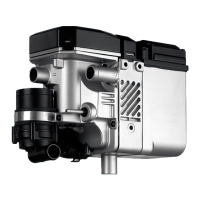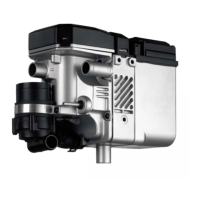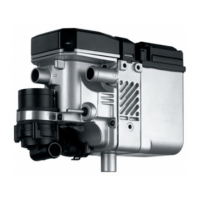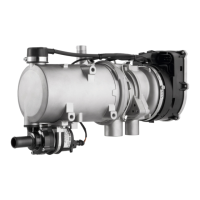Installation
www.webasto.us Webasto Product N.A., Inc. www.techwebasto.com
9
2. Installation
General Information
IMPORTANT
• The DBW 2010 must be installed outside the passenger cabin.
• The following temperature ranges apply to some components:
• ABS pipe system (G. Fischer) and fittings from -40°F - 140°F (-40°C to +60°C). Use a pipe system designed for
temperatures up to 248°F (120 °C), e.g. Hep2O made by Hepworth.
• Radial blower on the heat exchanger (arranged on inlet side) up to 131°F (55 °C)
• For this reason, a DBW 2010 with a specialized control unit must be used. The heater has a pre-programmed
nominal temperature of 126°F (52 °C).
• DBW 2010 Heater – 12 volt diesel
• If the volume of water in the circuit is too small less than 2.5gal. (10 liters), the heating system may shut down
prematurely. To avoid this, a storage tank should be installed ahead of the heater.
• The heater is incorporated into the water circuit of the air conditioning unit by means of an additional, electrical 3-
way valve. Activation is controlled by the TECC card within the Webasto Blue Cool Premium (WBCP) air conditioning
unit.
• The heater is powered by 12 volt battery voltage. The heater is activated by the electronic control unit via a 12 volt
signal wire. The Webasto BlueCool Premium Air Conditioning Unit functions with 110 or 220 volts.
• The circulation pump (P1) operates continuously when the system is switched on. This means there is no need for
the circulating pump on the heater. As a result, it is integrated directly at the heater inlet. A cool down cycle is
assured from program version 413 of the TECC card onwards.
• The DBW 2010 offers excellent heat capacity to an air handler power up to 31,000 BTU.
• If an external heater is incorporated into a Webasto Blue Cool Premium System with an electrically operated 3-way
valve, function F 04: “Automatic with External Heater” or function F 05 “Heat Cycle Only with External
Heater” must be preset on the Chiller Control and the operating element must be blocked by a code.
• When connecting the heater, it is essential that the correct terminal is selected for the nominal temperature.
NOTE: If the vessels manufacturer has issued separate instructions, they must be followed.
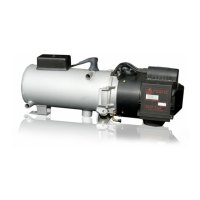
